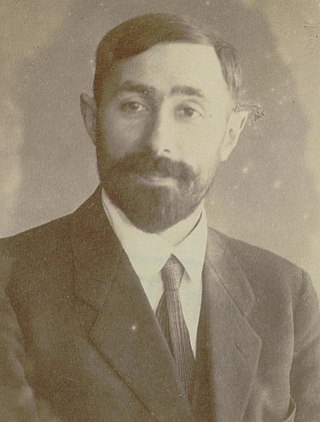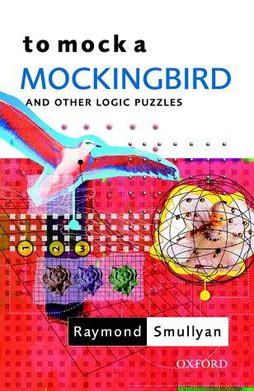
In algorithmic information theory, the Kolmogorov complexity of an object, such as a piece of text, is the length of a shortest computer program that produces the object as output. It is a measure of the computational resources needed to specify the object, and is also known as algorithmic complexity, Solomonoff–Kolmogorov–Chaitin complexity, program-size complexity, descriptive complexity, or algorithmic entropy. It is named after Andrey Kolmogorov, who first published on the subject in 1963 and is a generalization of classical information theory.
Lambda calculus is a formal system in mathematical logic for expressing computation based on function abstraction and application using variable binding and substitution. Untyped lambda calculus, the topic of this article, is a universal model of computation that can be used to simulate any Turing machine. It was introduced by the mathematician Alonzo Church in the 1930s as part of his research into the foundations of mathematics. In 1936, Church found a formulation which was logically consistent, and documented it in 1940.
In theoretical computer science and mathematics, the theory of computation is the branch that deals with what problems can be solved on a model of computation, using an algorithm, how efficiently they can be solved or to what degree. The field is divided into three major branches: automata theory and formal languages, computability theory, and computational complexity theory, which are linked by the question: "What are the fundamental capabilities and limitations of computers?".
Combinatory logic is a notation to eliminate the need for quantified variables in mathematical logic. It was introduced by Moses Schönfinkel and Haskell Curry, and has more recently been used in computer science as a theoretical model of computation and also as a basis for the design of functional programming languages. It is based on combinators, which were introduced by Schönfinkel in 1920 with the idea of providing an analogous way to build up functions—and to remove any mention of variables—particularly in predicate logic. A combinator is a higher-order function that uses only function application and earlier defined combinators to define a result from its arguments.
In combinatory logic for computer science, a fixed-point combinator, is a higher-order function that returns some fixed point of its argument function, if one exists.
In programming language theory and proof theory, the Curry–Howard correspondence is the direct relationship between computer programs and mathematical proofs. It is also known as the Curry–Howard isomorphism or equivalence, or the proofs-as-programs and propositions- or formulae-as-types interpretation.
Computability is the ability to solve a problem in an effective manner. It is a key topic of the field of computability theory within mathematical logic and the theory of computation within computer science. The computability of a problem is closely linked to the existence of an algorithm to solve the problem.
The B, C, K, W system is a variant of combinatory logic that takes as primitive the combinators B, C, K, and W. This system was discovered by Haskell Curry in his doctoral thesis Grundlagen der kombinatorischen Logik, whose results are set out in Curry (1930).

Moses Ilyich Schönfinkel was a logician and mathematician, known for the invention of combinatory logic.
The SKI combinator calculus is a combinatory logic system and a computational system. It can be thought of as a computer programming language, though it is not convenient for writing software. Instead, it is important in the mathematical theory of algorithms because it is an extremely simple Turing complete language. It can be likened to a reduced version of the untyped lambda calculus. It was introduced by Moses Schönfinkel and Haskell Curry.
In computer science, and more specifically in computability theory and computational complexity theory, a model of computation is a model which describes how an output of a mathematical function is computed given an input. A model describes how units of computations, memories, and communications are organized. The computational complexity of an algorithm can be measured given a model of computation. Using a model allows studying the performance of algorithms independently of the variations that are specific to particular implementations and specific technology.
The simply typed lambda calculus, a form of type theory, is a typed interpretation of the lambda calculus with only one type constructor that builds function types. It is the canonical and simplest example of a typed lambda calculus. The simply typed lambda calculus was originally introduced by Alonzo Church in 1940 as an attempt to avoid paradoxical use of the untyped lambda calculus.

Programming language theory (PLT) is a branch of computer science that deals with the design, implementation, analysis, characterization, and classification of formal languages known as programming languages. Programming language theory is closely related to other fields including mathematics, software engineering, and linguistics. There are a number of academic conferences and journals in the area.

To Mock a Mockingbird and Other Logic Puzzles: Including an Amazing Adventure in Combinatory Logic is a book by the mathematician and logician Raymond Smullyan. It contains many nontrivial recreational puzzles of the sort for which Smullyan is well known. It is also a gentle and humorous introduction to combinatory logic and the associated metamathematics, built on an elaborate ornithological metaphor.
In formal language theory and computer science, Iota and Jot are languages, extremely minimalist formal systems, designed to be even simpler than other more popular alternatives, such as lambda calculus and SKI combinator calculus. Thus, they can also be considered minimalist computer programming languages, or Turing tarpits, esoteric programming languages designed to be as small as possible but still Turing-complete. Both systems use only two symbols and involve only two operations. Both were created by professor of linguistics Chris Barker in 2001. Zot (2002) is a successor to Iota that supports input and output.
Combinatory categorial grammar (CCG) is an efficiently parsable, yet linguistically expressive grammar formalism. It has a transparent interface between surface syntax and underlying semantic representation, including predicate–argument structure, quantification and information structure. The formalism generates constituency-based structures and is therefore a type of phrase structure grammar.
Computable topology is a discipline in mathematics that studies the topological and algebraic structure of computation. Computable topology is not to be confused with algorithmic or computational topology, which studies the application of computation to topology.
In mathematical logic, the Scott–Curry theorem is a result in lambda calculus stating that if two non-empty sets of lambda terms A and B are closed under beta-convertibility then they are recursively inseparable.




